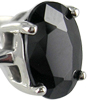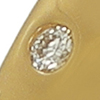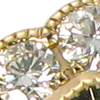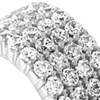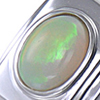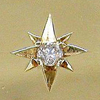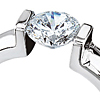Gemstones- are precious or semi-precious stones, cut, polished and often used in jewellery.
Gemstone values vary widely according to colour, clarity, cut and their weight which is measured in carats (one carat = 0.2g).
Examples of the more familiar gemstones:
Diamond,
The Corundums which are Ruby and Sapphire,
The Beryls which are Emerald and Aquamarine.
Opals, Topaz, Tourmaline, Garnet, Peridot, Spinel, Zircon. Quartz which also includes stones such as Amethyst, Onyx, Citrine, Jasper and Tigers Eye.
Read in detail about the more popular gemstones used in Jewellery.
Rocks and Minerals have been used in jewellery and decorations for thousands of years the best known are Jade, Lapis Lazuli and Turquoise.
Organic Gems are those derived from animal or plants they include Amber (fossilized tree resin), Jet (fossilized compressed trees), Coral, Pearl, Ivory and Shells.
Scientists have been making Synthetic gemstones, including diamonds, for a number of years. The term synthetic describes any material that is produced in a laboratory through chemical-physical processes created by a human controlled process. Synthetic gemstones have the same physical properties and chemical composition as naturally occurring gemstones. They tend to be flawless and be of a more vivid colour than their natural counterparts.
The Mohs Scale- is used to determine hardness. Hardness is a measure of a mineral's resistance to abrasion and reflects the atomic structure of a mineral. Generally a high scratch resistance is desirable for gemstones and a Moh's hardness of 7 or higher is important. The principal reason is that a common cause of abrasion is sand, which is silica grit (quartz) and is commonly present in dust. Stones which are softer than quartz are not suitable for every day use as facetted jewellery gemstones, particularly in rings, although many are beautiful and attractive.
Some gems, such as pearls, coral, turquoise, lapis lazuli, amber and opal are quite soft. These are usually polished into cabochons or beads rather than facetted and therefore do not show scratches so easily.
Supply- we stock a large range of the most common gem stones including diamonds and can supply a variety of grades and sizes. We have suppliers who can provide the more unusual stones. If necessary we can supply stones on approbation (appro) for you to show your customer under no obligation to buy. We can also supply and cut stones to fit settings if they are not stock sizes.
A large proportion of the coloured gem sold globally, that will include Sapphires, Rubies and Emeralds, are heat treated and therefore this may potentially be the case in our products.
Recut, Repolish- on some softer stones e.g. opal, emerald and garnet the surface can wear away and may, after some years, need to be repolished or recut by a lapidary (a stone cutter). The harder stones such as diamond, ruby and sapphire can also chip or wear over time and these can also be recut. The cost price does vary according to the amounts of facets (surfaces of the stone) the size and its hardness. The procedure can take 3-6 weeks. In some cases it is cheaper to replace the stone than have a damaged stone recut.
Setting Techniques- stones are secured into their settings by first cutting a seat in which the stone rests and then covering the stone from above with some additional metal. This traps the stone so that it cannot move down or up. The setter (the person who sets stones) has several options on how to secure a stone into a mounting. The most common settings are Claw Setting or Grain Set other styles are Rub Over, Pave, Channel, Illusion, Star Setting, Invisible Setting, Suspension Setting and Countersunk.
Read about the different styles of settings in more detail.
















